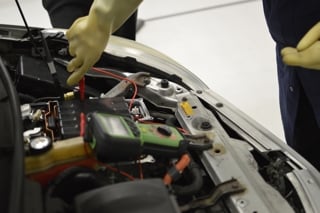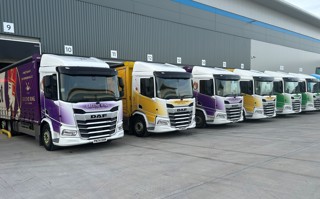This feature originally appeared in the July 2022 edition of Fleet News. Click here to read the article in the digital issue of the magazine.

It is no secret that due to a series of seismic world events, most fleets are struggling to get their hands on new vehicles.
Factors such as the Covid-19 pandemic, the blocking of the Suez Canal and war in Ukraine are causing a shortage of critical parts and components, leaving organisations facing lengthy lead times between ordering a vehicle and taking delivery of it.
Compounding this is that fleets are being starved of stock in preference to the retail market, says Peter Golding, founder of FleetCheck.
“If manufacturers can sell with no discount to retail buyers and the benefit to fleet is substantial reductions, then keeping a vehicle longer starts to make more sense,” he says.
“This is going to bring a long-term change because the supply of vehicles is an ongoing problem.”
The scale of the issue was highlighted in the recent British Vehicle Rental & Leasing Association (BVRLA) Technical and Operational Management forum which showed the average age of a vehicle on fleet grew from three years in 2019 to a little more than three-and-a-half years in 2022.
This trend was also highlighted in the 2021 Operational Fleet Insight Report, produced by the AA in partnership with Rivus Fleet Solutions.
This showed that 16% of commercial van users increased the lifespan of their older vehicles in response to the circumstances created by the pandemic.
One consequence of a vehicle being kept beyond the length of time they were originally meant to serve on a fleet is that the original total cost of ownership (TCO) calculations no longer apply: service, maintenance and repair (SMR) costs will rise due to increased wear and tear.
To date, it has been quite common for company vehicles to be operated on a 36-month term and be returned or sold as they become due for an MOT. Obviously, four or five years on fleet would cross that threshold.
A vehicle may also now be on the road outside its warranty, leaving some items unprotected;
and, for older fleet vehicles, low emission zones are proving newly relevant and expensive.
Increased vehicle off-road time is another consequence of more SMR.
Managing it has always been important, but now that rental vehicles are also in short supply, getting a daily hire to tide drivers over while vehicles are maintained or while waiting for a new one is often no longer an option.
Taking action
There are a number of actions fleet managers can take to mitigate the increased costs.
The first is to collect data about the performance of both vehicles and drivers.
This can often be done through a provider’s app on the driver’s smartphone, which guides them through the information needed to paint an accurate picture, or telematics.
These tools allow fleet managers and their SMR provider to use data to predict what might go wrong and when.
“That means we can start to schedule in maintenance according to the mileage and plan that to minimise downtime,” says David Bushnell, director of consultancy and strategy for Fleet Operations.
The information also highlights which vehicles are least reliable and which drivers are the highest risk, giving opportunities for further remedial action.
Bushnell adds fleet operators should make sure driver responsibilities are enforced.
“Drivers will get frustrated with older vehicles because they wanted a new one,” he says. “And try to manage overdue or missed services.”
Other measures which can reduce SMR costs include ensuring vehicles are not overloaded, says Simon Staton, managing director at Venson Automotive Solutions.
“Overloading can have an impact on tyre wear,” he adds. “Drivers should be educated on the cost of SMR incidents they may contribute to such as tyre damage.”
This should encourage them to take more care of their vehicles.
Staton says fleets can also save money by balancing operational and financial objectives with satisfying driver needs.
“A fleet manager may be using a panel van for roles where an estate car could suffice,” he adds.
And where vehicles are not being used, these can become part of a pool to be deployed instead of using rental when vehicles are off the road.
Escalating fuel prices are also alleviated by this approach – fuel efficiency and a good driving style are paramount.
Paul Hollick, chair of the Association of Fleet Professionals, says: “Fleet managers should also work closely with their insurer to see their premiums do not go up as vehicles get older and make sure drivers are aware that their vehicle needs to go in for a service – telling a driver to book into a dealership does not necessarily mean they will do it.”
Many van operators are moving vehicles from a four-year contract to six years; the vehicles are durable and they carry kit such as cameras, telematics and custom racking, so the cost of defleeting that vehicle is more expensive than keeping it.
“Electric vehicles are also showing durability and operators will realise that running them for six years is not prohibitive,” says Golding.
Pay-as-you-go maintenance
All these factors may lead to fleet managers opting for pay-as-you-go contracts rather than a bundled maintenance package.
FleetCheck has seen this happening. “It can be cost-effective and we work closely with Epyx on the 1Link programme for this,” says Golding.
Many leasing companies and SMR providers have a network of garages, sometimes with fixed prices. “Using a network over a main dealer brings a substantial reduction in labour costs,” says Golding.
“The exception to that is high-value marques such as BMW or Mercedes-Benz with high mileage, where going outside the main dealers could affect the residual value.”
And Fleet Assist recommends fleet managers have access to an eclectic garage network that offers options such as franchised dealers, independents, fast-fit and mobile to cover all corners, as many repairers were offering restricted services or were closed during lockdowns.
“By working with a trusted partner, businesses can benefit from savings of up to 30% on standard dealership labour rates and parts, and all prices in our UK garages are checked for fairness and consistency,” says Penny Stoolman, managing director of Prestige Fleet Servicing.
Fleets could also regulate mileage peaks in vehicles by reallocating vehicles from a high-mileage driver to a low-mileage employee and vice versa to further reduce maintenance bills.
But Golding points out: “On commercial vehicles that’s more acceptable, but people can be very protective of their cars because they are paying BIK (benefit-in-kind tax) on them, and car buyers are driven by the perk of a company car rather than the practicality.”
Managers are also turning to grey fleet vehicles to keep down costs. “This will continue to rise;
40% of work vehicles on the UK’s roads can now be categorised as grey fleet,” says Stoolman.
But managers remain responsible for ensuring a vehicle used for business is maintained and roadworthy, even if their company doesn’t own it, she adds.
Be proactive
A growing number of fleets, including British Gas and national police fleets, are offsetting parts delays by using salvage or recycled parts for non-structural repairs via the likes of Synetiq and Copart.
Former British Gas head of fleet Steve Winter is a major advocate.
“What surprises me is the number of fleets which aren’t considering the use of green parts,” he says. “The cost savings and environmental benefits are clearly visible.”
Organisations should also be questioning how they do things and consider seemingly outside-the-box actions such as viewing their fleet operation as a potential revenue generator, says Rory Mckinnon, sales director at Holman.
“Proactive fleet management ensures vehicles are inspected more often – every 12-to-26 weeks, dependent on usage,” he adds. “This will avoid unscheduled maintenance that is more costly in terms of the actual work and vehicle downtime.”
Tyre inspections are a case in point. If a driver pre-books a change, the tyres will be on the shelf when they turn up at the garage, and compliant with company policy on brand and price.
“And, through finance lease, they benefit from higher residual values at disposal time and reduced extension rentals thanks to lower depreciation. This allows them to offset some SMR costs against the upsides of the vehicle market,” adds Mckinnon.
“The more customers use a vehicle, the more maintenance costs can be linked to the income generated by the asset; and conversely, once the wheels stop turning, so does the cost, which became clear during the pandemic.”
If fleet managers change the way they operate their fleets, collect data and use that proactively, they can mitigate the worst of long lead times and resulting costs.It takes planning and a constructive approach.
But, given the perfect storm businesses are facing, these are necessities, not options.
Written by Catherine Chetwynd

















Login to comment
Comments
No comments have been made yet.